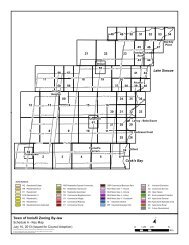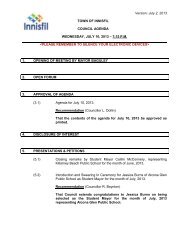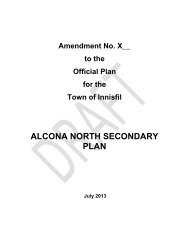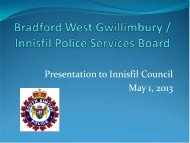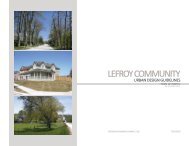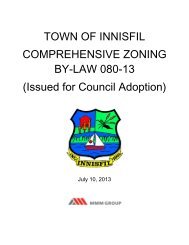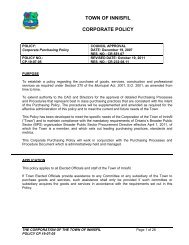Innisfil Official Plan OMB Approved - Town of Innisfil
Innisfil Official Plan OMB Approved - Town of Innisfil
Innisfil Official Plan OMB Approved - Town of Innisfil
You also want an ePaper? Increase the reach of your titles
YUMPU automatically turns print PDFs into web optimized ePapers that Google loves.
<strong>Town</strong> <strong>of</strong> <strong>Innisfil</strong> <strong>Official</strong> <strong>Plan</strong>CULTURAL HERITAGE AND ARCHAEOLOGY6.3 The register may also include built heritage resources that have not been designated butthat the <strong>Town</strong> Council or local heritage committee believes to be <strong>of</strong> cultural heritagevalue or interest.6.4 A heritage committee shall be appointed to identify the register <strong>of</strong> built heritageresources, and shall not contain fewer than five members.6.5 The heritage committee shall identify the register <strong>of</strong> built heritage resources based onthe criteria provided in Sections 6.6 and 6.7 and may also identify significant culturalheritage landscapes.6.6 Cultural Heritage Resources generally fall into one <strong>of</strong> two categories: those <strong>of</strong> historicvalue and those <strong>of</strong> architectural value.a) Cultural Heritage Resources <strong>of</strong> historic value can be described as follows: Those that serve as an example <strong>of</strong> the <strong>Town</strong>'s past social, cultural, political orphysical development; Those that serve as an example <strong>of</strong> outstanding work by a local or nationalpersonality; and Those that date from an early or significant period in the <strong>Town</strong>’s development.b) Cultural Heritage Resources <strong>of</strong> architectural value can be described as follows: Those that serve as a representative example <strong>of</strong> style, design or period <strong>of</strong>building; Those that serve as a representative example <strong>of</strong> a method <strong>of</strong> construction whichwas used during a certain time period or rarely used today; Those that serve as an important <strong>Town</strong> landmark; and Those that make an important contribution to the area composition or streetscape<strong>of</strong> which it forms a part.6.7 Cultural Heritage Resources may also include property or area that is recognized by theProvince as being archaeologically significant. By-laws under the Ontario Heritage Actmay be passed to designate properties <strong>of</strong> historical or architectural significance.6.8 The <strong>Town</strong> may establish design principles for buildings in proximity to HeritageConservation Districts or Heritage Conservation buildings.6.9 As part <strong>of</strong> any new Secondary <strong>Plan</strong> study, a heritage consultant shall be retained toidentify buildings considered to be significant cultural heritage resources and significantcultural heritage landscapes and add these to the register.6.10 Development applications on lands adjoining or contiguous to a protected heritageproperty shall demonstrate that the heritage attributes <strong>of</strong> the protected heritage propertywill be conserved.6.11 A stage 1 archaeological assessment shall also be prepared as part <strong>of</strong> any Secondary<strong>Plan</strong> study, and where there is potential for agricultural resources, a stage 2archaeological analysis shall be required prior to plan <strong>of</strong> subdivision or site planapproval.105Adopted July 26, 2006 <strong>Approved</strong> by <strong>OMB</strong> May 2009, March 2010 & April 8, 2011





